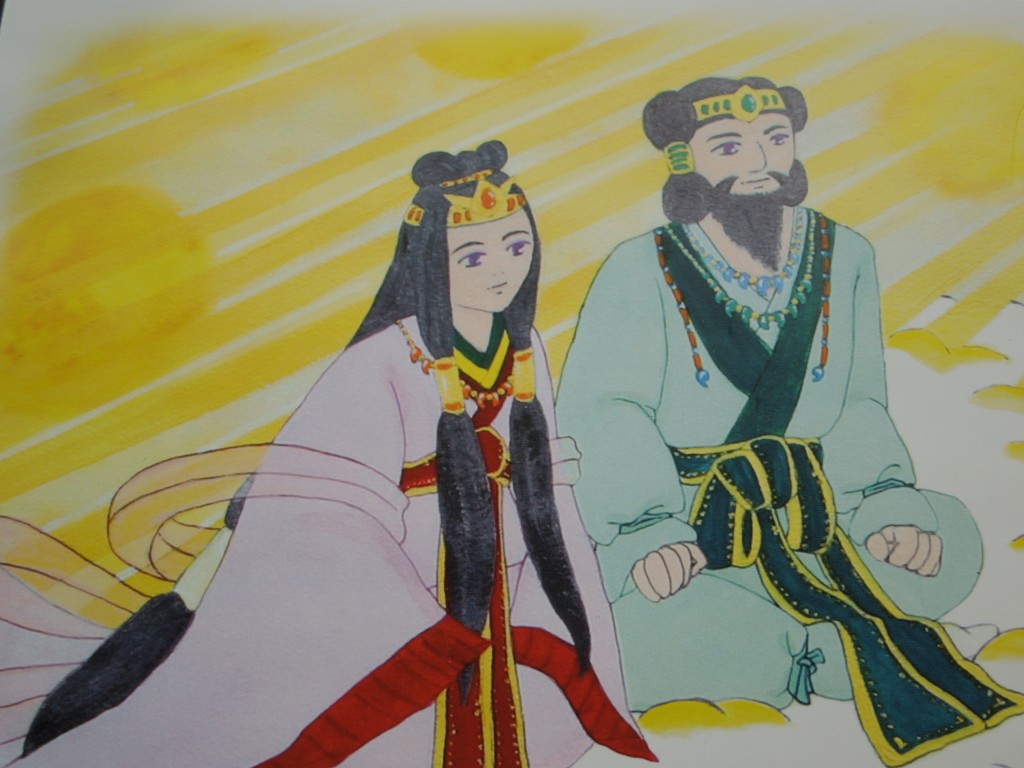
Japan’s primal pair, Izanagi and Izanami
Japan’s Creation Myth
The Creation of Japan myth (kuniumi shinwa) goes something like this. The deities of heaven (Takamagahara) ask a male and female pair to descend to the unformed land below and create order there so people could live. The two deities were Izanagi (He Who Invites) and Izanami (She Who Invites). They are entrusted with a Heavenly Spear (Amenonuboko) and walk out onto the floating bridge of heaven (thought to represent a rainbow).
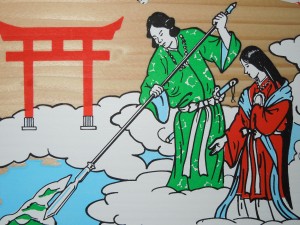
Izanagi and Izanami stir the primordial mass and create Awaji Island (taken from the shrine ema)
‘Let us stir the lower land with this spear,’ says Izanagi, whereupon the pair stir the primordial mass, before pulling out the spear. Some drops fall down from it and congeal, forming Onogorojima (Self-Revolving Island). Izanagi and Izanami descend there and build a palace.
On Onogorojima they also erect a large pillar around which the two deities perform a mating ritual by circling in opposite directions. Izanami speaks first, which was improper, and as a result their first child is a misbirth.
Only after Izanagi initiates the exchange do the pair give birth to a healthy child – namely Awaji Island (near Kobe). It was the first island in what was to become Japan.
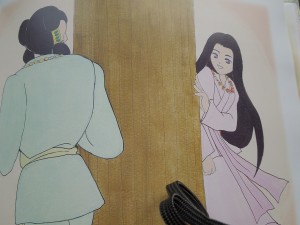
Izanagi and Izanami circle the pillar
Afterwards the pair give birth to other islands, producing in this way the Land of the Great Eight Islands. They then produce another 35 deities, such as that of the household, of the sea, of food, etc. etc. Their last child is the kami of fire, Kagutsuchi, which causes the death of Izanami during childbirth by singeing her private parts. She ends up in Yomi (the underworld), and the distraught Izanagi goes to visit her there. Against her wishes he looks at her rotting body, and outraged she sets the Japanese equivalent of the Furies on him, chasing him out altogether.
Polluted by his time in the underworld, Izanagi ritually cleanses himself in what is celebrated as the first ever misogi (cold water austerity). Because of the invigorating nature of the purification, he gives birth to a number of important deities. From his left eye appears Amaterasu, the sun goddess; from his right eye appears Tsukiyomi, the moon god; and from his nose comes Susanoo, the storm god.
Such is the charming Creation Myth of Japan, and on Sunday I went to visit the shrine most closely connected with the events. Izanagi Jingu stands in the middle of Awaji Island, and the shrine claims to house the grave of the mythical Izanagi beneath its honden (sanctuary). The illustrations here are taken from a book sold at the shrine done by Nageishi Fumiko, but before describing the visit a few observations on the myth itself.
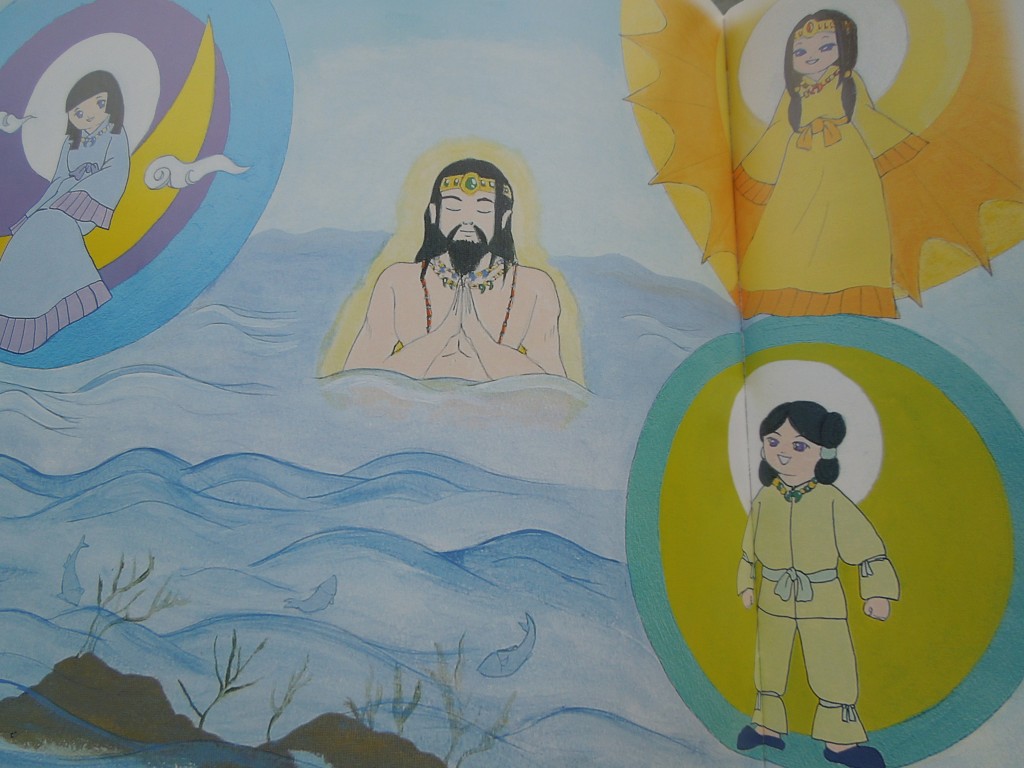
Izanagi giving birth to Amaterasu, Tsukiyomi and Susanoo
Interpretation
in terms of interpretation, the myth opens itself up in a rather obvious way to the image of a phallic spear dripping sperm and producing offspring. Far from being primitive, you could say that’s pretty enlightened in terms of the creation of life. But it’s possible to see other elements too in the myth, particularly yin-yang.
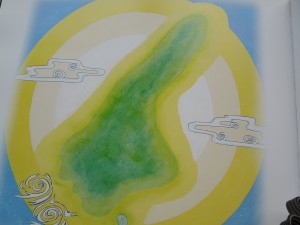
The phallic shape of Awaji Island: reason for its choice as Japan’s first creatiion?
The myth was first written down towards the end of the seventh century, appearing in two different books Kojiki (712) and Nihon shoki (720). It was an age when Chinese influence was strong, and the coming together of Izanagi and Izanami as the primal yang and yin was envisaged as the primary generative force. The yin-yang circle of life is represented in the story by circular patterns: stirring the primal chaos; the Self-Revolving Island, circumambulating the pillar.
In addition, the plus-minus nature of yin-yang is caught in a dialogue which takes place before the pair copulate (translator B.H. Chamberlain found the passage so indelicate that he rendered it in Latin rather than English!). Izanami declares that her body has a part missing, whereupon Izanagi announces that his body has an extra part. Why not join his extra part to her missing part? It proves a perfect match, a complete union, a harmony of male and female. The two complement each other perfectly, in the manner of the two parts of the yin-yang symbol. In the coming together is generated a whole new world.

Izanagi tosses a tooth from his comb at the demons
As well as the yin-yang symbolism, there’s reference in the august pillar to the World Tree or Central Axis of shamanistic cultures. The imagery was of a connection between the three different worlds (upper, middle and lower) that comprise the universe. It enabled the shaman to move psychically between them.
Pillars of course can be seen in phallic terms, and it’s interesting to note in this respect that the counter for Japanese kami is the word for pillar (hashira). Why? I’ve never seen a good explanation, but it must surely be related to the idea of fertility. Shamanism, as Shinto, champions the lifeforce. Death, decay and disease by contrast are shunned as ‘pollution’. It explains why the religion is uninterested in morality, for it focusses on the affirmation of life instead. Purification, renewal and reinvigoration is the Shinto way, and the august pillar that reaches up to heaven speaks of a divine connection.
Now here’s the interesting thing: when Izanagi is being chased by demons out of the underworld, he throws various things at them to scare them off. One is his head-dress or wreath, which turns into grapes. Another is a tooth comb, which turns into bamboo-sprouts. And a third item are peaches. So there’s an opposition here of food and sustenance fighting off the forces of death. Interestingly, there’s a phallic symbolism to the teeth of the comb becoming bamboo shoots (if I’m not mistaken, the tooth is counted as ‘pillar’). And the peach in Japan is well-known as a female sexual symbol.
In this way the lifeforce is championed as superior to the dark forces opposed to it. This is confirmed at the end of the story after Izanagi’s escape, when the still furious Izanami threatens to kill a thousand people a day to punish him. In response Izanagi declares he will build a thousand five hundred birthing huts. Life will go on!! The lifeforce is triumphant.
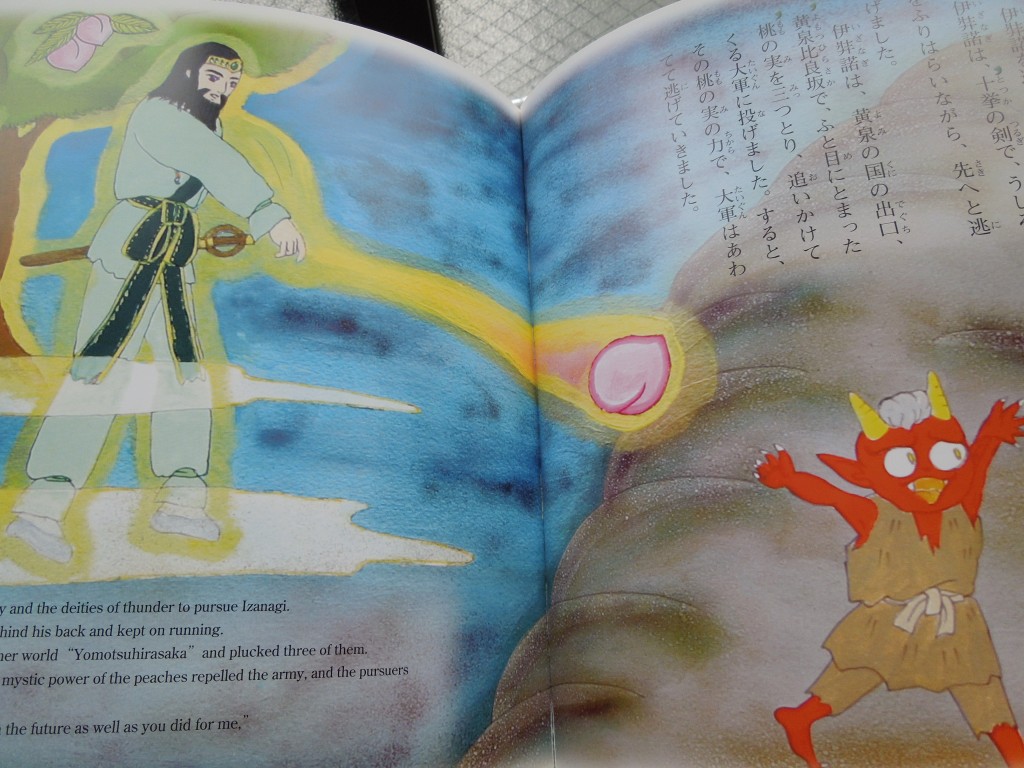
Izanagi hurls a peach at the demons pursuing him

fascinating stuff, John — so very different from Korea’s foundation-story — i love what you do on this blog!
Thanks, David. For those who don’t know, David runs a wonderful website about Korea’s sacred mountains and the San-shin spirits associated with them.
Search for San-shin, or visit http://www.san-shin.org/
thanks so much for introducing this shrine!
Should visit there also this summer!
Gabi from Okayama
Thanks, Gabi. I should say to readers who don’t know that Gabi Greve runs the popular Joys of Japan site on Facebook as well as the impressive Daruma Museum blog all about Japanese culture and curiosities…
Can I get the book by mail? I’d love to have it, and I can’t go to Japan (although I’d love to go sometime in my life).
Yes, you can get the book from amazon.jp. It’s mostly bilingual as you can see, though not article at the end. http://www.amazon.co.jp/%E5%9B%BD%E7%94%9F%E3%81%BF%E7%A5%9E%E8%A9%B1%E2%80%95%E6%97%A5%E6%9C%AC%E3%81%AE%E3%81%AF%E3%81%98%E3%82%81%E3%81%A8%E6%B7%A1%E8%B7%AF%E5%B3%B6-%E5%BB%A3%E5%B2%A1%E5%BE%B9/dp/4990431715/ref=sr_1_1?ie=UTF8&qid=1456618764&sr=8-1&keywords=%E5%9B%BD%E7%94%9F%E3%81%BF%E7%A5%9E%E8%A9%B1